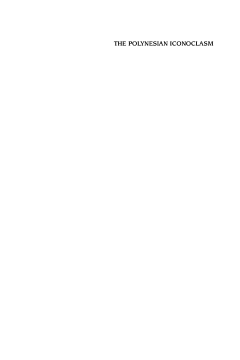
Additional Information
Book Details
Abstract
Within little more than ten years in the early nineteenth century, inhabitants of Tahiti, Hawaii and fifteen other closely related societies destroyed or desecrated all of their temples and most of their god-images. In the aftermath of the explosive event, which Sissons terms the Polynesian Iconoclasm, hundreds of architecturally innovative churches — one the size of two football fields — were constructed. At the same time, Christian leaders introduced oppressive laws and courts, which the youth resisted through seasonal displays of revelry and tattooing. Seeking an answer to why this event occurred in the way that it did, this book introduces and demonstrates an alternative “practice history” that draws on the work of Marshall Sahlins and employs Bourdieu’s concepts of habitus, improvisation and practical logic.
“This is an enormously rewarding book, marshalling an abundance of historical and ethnographic evidence in support of a compelling argument that the Polynesian iconoclasm, despite outward appearances, was a very ‘traditional’ type of rupture in which missionaries and their god initially played supporting roles.” · Asia Pacific Viewpoint
“Sissons’s argument about the seasonality of power, and his use of Hocart to think about ritual and centralisation, are persuasive and skillful. The book is a useful reminder that older theoretical tools can be sharpened for newer analytic purposes he book is valuable for scholars of Oceania and Christianity. Sissons handles an impressive range of historical information adeptly.” · The Asia Pacific Journal of Anthropology
“…fascinating and highly recommended to scholars interested in ritual and religion, religious change, and culture change. Sissons’s study of Polynesian iconoclasm shows the value of sustained and in-depth archival research and reminds us about the advantages and limitations of the use of stable classifications and that this kind of historical research tends to invite analyses that focus on causes instead of effects of social and cultural change. It is a contribution to the scholarship on Christianity that looks at ‘Christianity’ as a cause of change in relation to continuity.” · Journal of Religious and Political Practice
“This short but interesting and important study of the intentional overthrow of traditional religions in Polynesian cultures and the embrace of Christianity illustrates how these events were not complete breaks with tradition but versions and improvisations of pre-Christian practices of seasonal destruction and reconstruction of sacred spaces and social orders.” · Anthropology Review Database
“The book is blessed with an intrinsically interesting subject matter: the way in which the religious basis of societies all across Polynesia was suddenly torn up and deliberately rejected within a decade or two. The author succeeds in highlighting how extraordinary and dramatic the ‘Polynesian Iconoclasm’ was, drawing our attention to it as a coherent phenomenon, and penetrating these convulsions more deeply than other scholars have managed hitherto.” · Alan Strathern, University of Oxford
“The book is an ethnographic tour de force describing in great detail the conversion to Christianity in a number of Polynesian societies. The ethnographic argument is solid and the book would be excellent addition to the interpretations of religious conversion, cultural change and Polynesian ethnography in general.” · Jukka Siikala, University of Helsinki
Jeffrey Sissons is Associate Professor of Anthropology at Victoria University of Wellington. He is the author of numerous publications on Maori and Polynesian history written over the past 25 years. His most recent book is First Peoples: Indigenous Cultures and their Futures (Reaktion Books, 2005).
